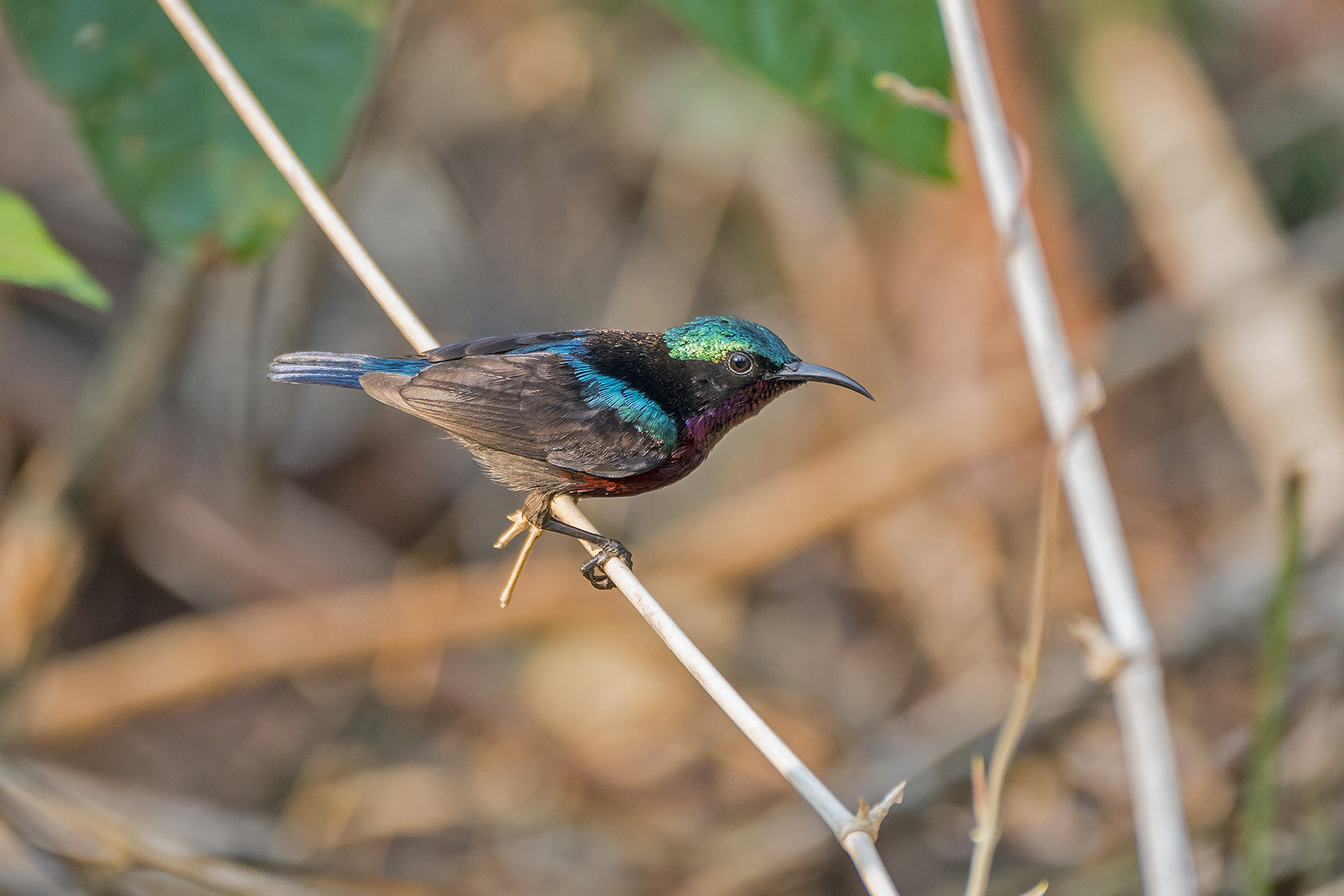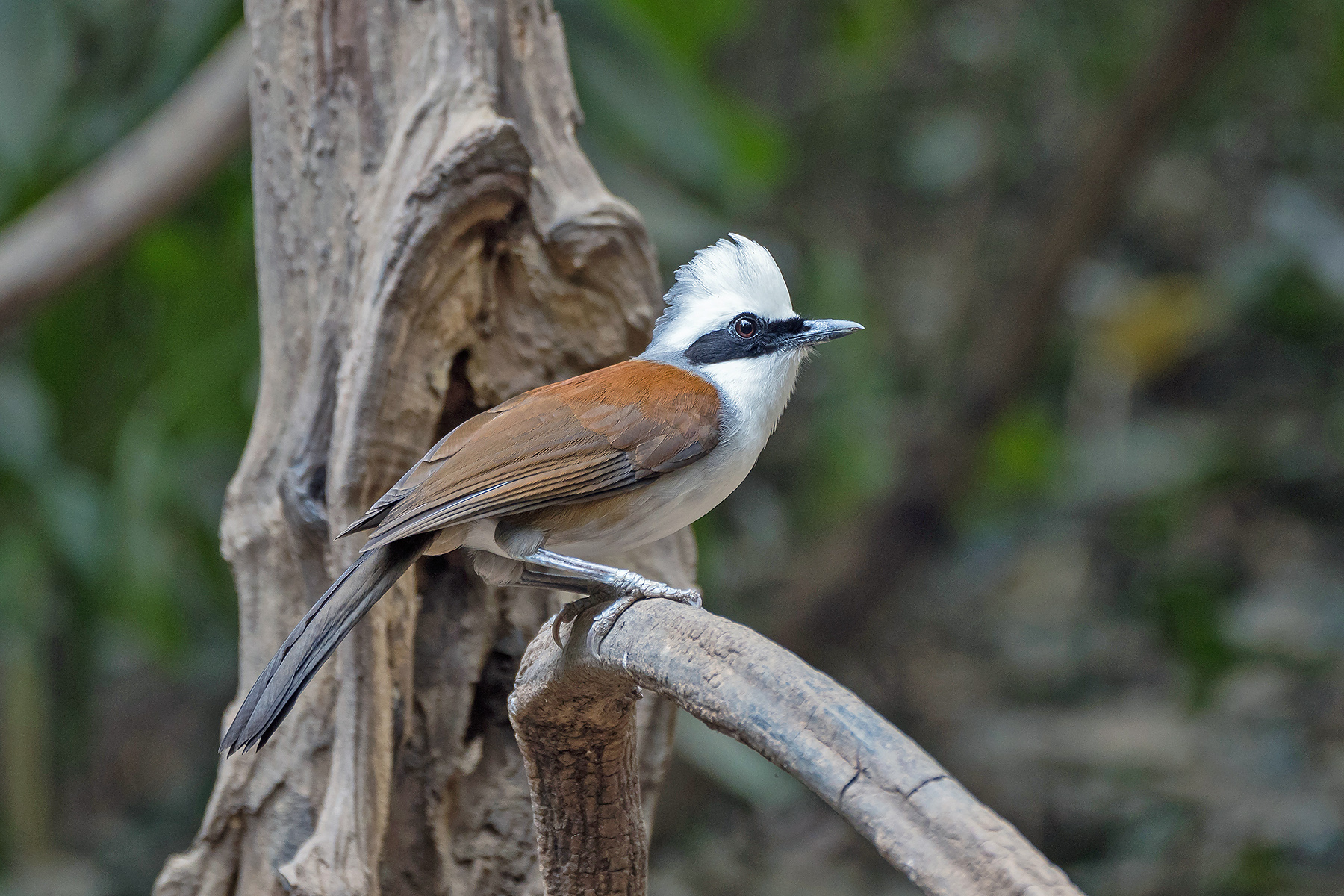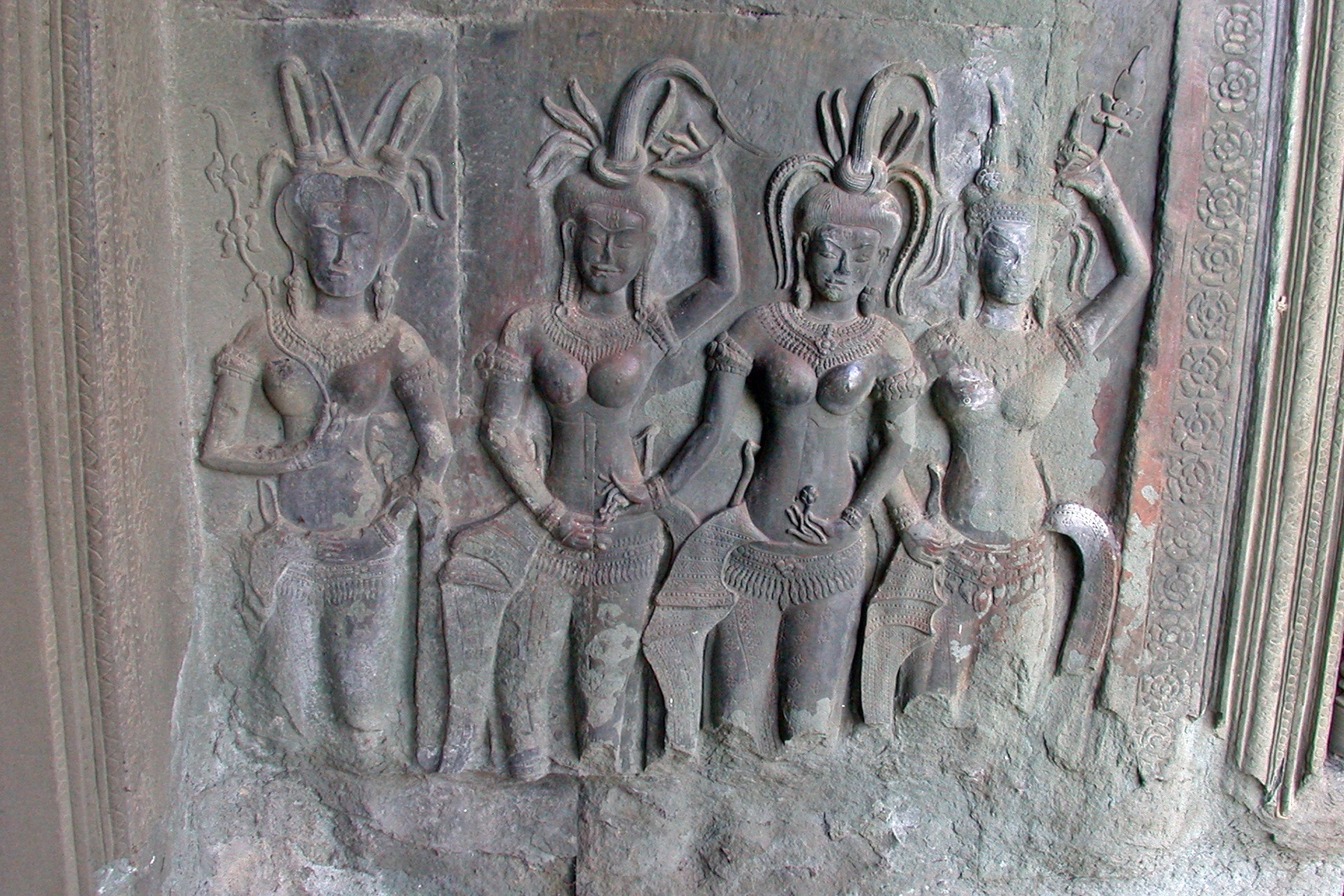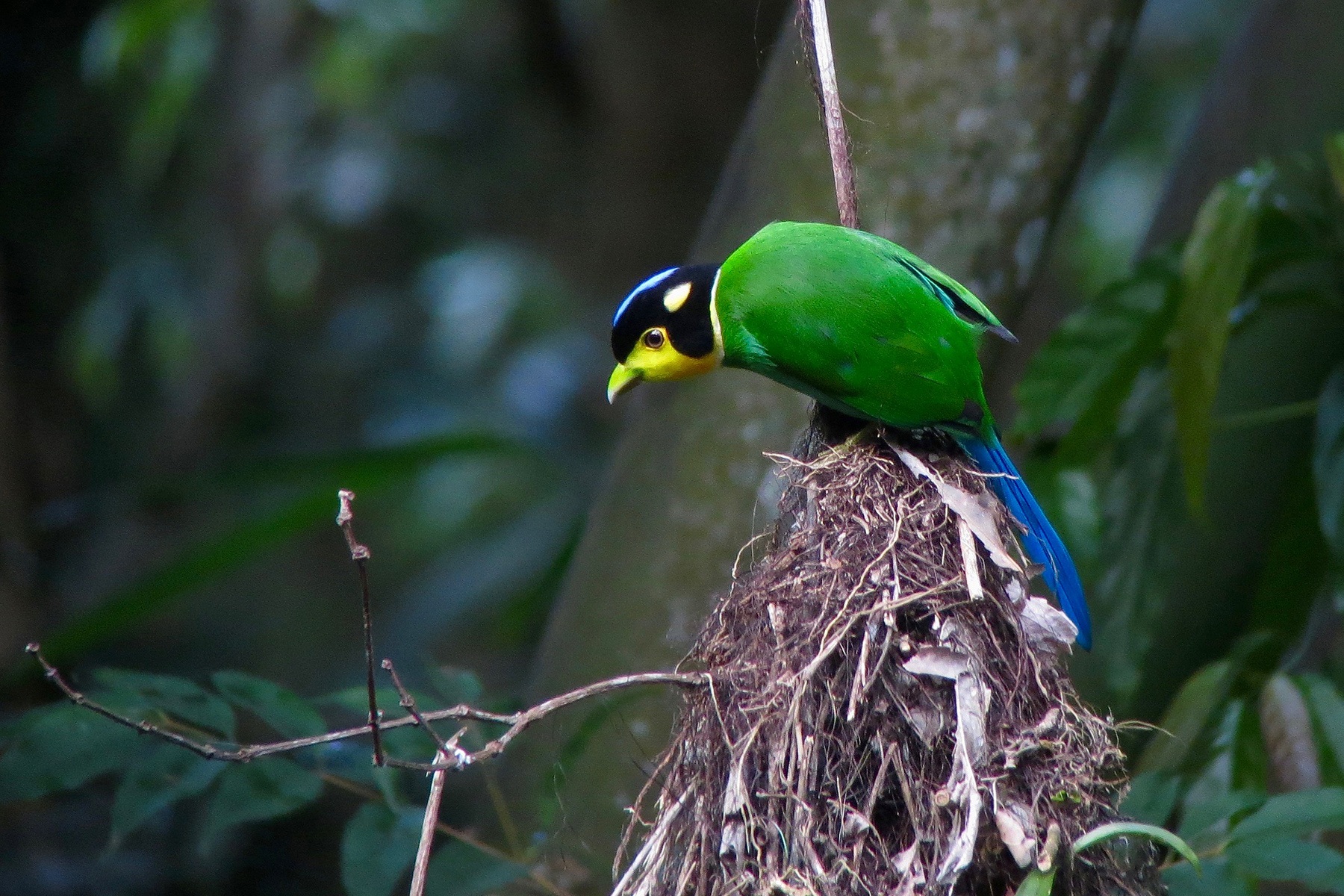CAMBODIA BIRDING TOUR WITH LAOS: DETAILED ITINERARY
Cambodia & Laos: Day 1 Afternoon tour start at Phnom Penh airport. From there we will transfer to the town of Udong, situated to the northwest of Cambodia’s capital city, for an overnight stay.
Cambodia & Laos: Day 2 This morning we will look for the pretty and easy-to-find endemic Cambodia Tailorbird. We will also come across a few widespread Cambodian birds.
Afterwards, we will drive northwestwards to the town of Pursat for an overnight stay. In the late afternoon, we will have our first opportunity to explore the grasslands and scrublands near Pursat.
Cambodia, Laos, Singapore & Malaysia: Day 3 The near-threatened Chinese Grassbird, a species that can otherwise only really be seen on the Birdquest Burma (Myanmar) tour or in Hong Kong, has recently been discovered near Pursat. We will be looking for this very special bird in the extensive grasslands that remain in this seldom-visited area, assisted by its distinctive vocalisations.
Another very special bird in these grasslands is the uncommon Manchurian (or White-browed) Reed Warbler. Here it is relatively easy to locate, which cannot be said for its breeding grounds in the area once known as Manchuria in Northeast China, where much habitat has been lost to overgrazing and more permanent agricultural changes.
There will be plenty of other birds to look for in the area, including Painted Stork, Asian Openbill, Chinese Pond Heron, Eastern Cattle Egret, Eastern Marsh and Pied Harriers, Oriental Pratincole, Lesser Coucal, Germain’s Swiftlet, Asian Palm Swift, Asian Green and Blue-tailed Bee-eaters, Freckle-breasted Woodpecker, Black Drongo, Racket-tailed Treepie, Eastern Jungle Crow, Horsfield’s Bush Lark, Barn and Red-rumped Swallows, Oriental Reed and Lanceolated Warblers, Striated Grassbird, Zitting and Golden-headed Cisticolas, Yellow-bellied and Plain Prinias, Common Tailorbird, Plain-backed Sparrow, Baya Weaver, Red Avadavat, Scaly-breasted Munia and Paddyfield and Red-throated Pipits.
We will also have our first chances for King (or Blue-breasted) Quail, Common Buttonquail and the ever-dwindling Yellow-breasted Bunting.
Afterwards, we will travel to Siem Reap, situated close to the vast Tonle Sap lake, for a three nights stay.
Cambodia & Laos: Days 4-5 While based at Siem Reap, we will visit the amazing ruins of Angkor Wat, one of the world’s most awesome cultural spectacles. The sacred remains here comprise around 100 temples and are only a small part of what was once a much larger religious and administrative centre. The complex was built between the 9th and 13th centuries AD to glorify a succession of Khmer kings. Most of Angkor was abandoned in the 15th century and the temples were gradually cloaked by forest. However, after renewed interest in the site in the late 19th century, the forest that threatened to completely engulf the temples was cut back and restoration work continues to this day.
Although it will be hard to tear ourselves away from these amazing cultural treasures, it will be impossible not to notice some birds in the surroundings of the temples. Amongst the species that we may well encounter are Spotted and Zebra Doves, colourful Red-breasted and Alexandrine Parakeets, Asian Barred Owlet, House Swift, Asian Palm Swift, Lineated and Coppersmith Barbets, Barn Swallow, Streak-eared and Yellow-vented Bulbuls, Oriental Magpie-Robin, Blue Rock Thrush (many are of the migrant rufous-bellied race philippensis), Common Tailorbird, Malaysian Pied Fantail, Black-naped Oriole, Common and Great (or White-vented) Mynas, and Eurasian Tree Sparrow. Angkor Wat is also a good site for the attractive Forest Wagtail.
Our stay at Siem Reap will give us the opportunity to visit a wetland of huge international importance. Today we will make an excursion by boat across the waters of the vast Tonle Sap to the huge waterbird colonies at Prek Toal. Tonle Sap is a huge fishery (and, in addition, up to a million water snakes are harvested here annually!) which provides a significant proportion of the entire protein intake of the Cambodian people! As a result, the fisheries of the lake are strictly protected and a by-product of this is that the waterbirds have been shielded from illegal poaching, resulting in the best remaining large waterbird colonies in Southeast Asia (if not the whole of Asia!).
Setting off from the shore of this huge lake, we will first pass a floating village before crossing the lake, accompanied by hundreds of Whiskered Terns and occasionally a few Brown-headed Gulls.
Once near to the colonies we will switch to smaller boats and proceed up small side channels to some observation platforms where we will soon be amazed by the sheer quantity of birds, as thousands of cormorants, pelicans, storks and herons are constantly in view!
Huge numbers of Indian Cormorants are joined by smaller numbers of Little and Great Cormorants and Oriental Darters. Mixed flocks of Little, Eastern Cattle, Great and Intermediate Egrets are joined by dozens of Grey and Purple Herons, Chinese Pond Herons (which can sometimes be compared side-by-side with Javan Pond Heron) and smaller numbers of Striated Herons and Black-crowned Night Herons. Asian Openbill is the commonest stork species, but these are joined by good numbers of Painted Storks and, in the frequent ‘kettles’ of storks overhead, we will look carefully for Lesser Adjutant and the endangered Greater Adjutant, both of which have good populations here. Spot-billed Pelicans (here at their only colony in Southeast Asia) are delightfully numerous and we will get many opportunities to watch the antics of these impressive beasts. Smaller numbers of Black-headed Ibises are mixed in with the colonies and we also have a good chance of finding the rare Milky Stork at its only known freshwater breeding colony in the world.
Raptors are also in evidence: the stately Grey-headed Fish Eagle is frequently encountered and we might also encounter Western Osprey and Brahminy Kite. Common Kingfishers and attractive Black-capped Kingfishers are sometimes seen along the channels and in the waterside vegetation, we may well encounter species such as Yellow and Cinnamon Bitterns, Common Moorhen, Bronze-winged Jacana, Greater Coucal, Green-billed Malkoha, Black-browed and Oriental Reed Warblers, Pallas’s Grasshopper (or Rusty-rumped) Warbler (common by voice but often hard to see) and Olive-backed Sunbird.
We may also encounter one or two of the scarcer species of the area, which include Black Bittern, Glossy Ibis, Ruddy-breasted Crake and Red-necked Phalarope. If we are really in luck we will find a Buffy Fish Owl at its daytime roost.
Close to Siem Reap, we will explore an area comprising open fields, rice paddies and marshy pools which is home to a wide variety of species. Our major target here is the declining Asian Golden Weaver and this area is probably now the best place in Cambodia to observe this interesting species.
The pools and partly-flooded paddies attract Lesser Whistling Duck, Indian Spot-billed Duck, Little Grebe, Pheasant-tailed Jacana, Black-winged Stilt, Oriental Pratincole, Little Ringed Plover, Pacific Golden Plover (uncommon), Black-tailed Godwit (uncommon), Common and Pin-tailed Snipes, Spotted Redshank, Common Greenshank, Marsh, Wood and Common Sandpipers, Long-toed Stint and Pied Kingfisher, whilst Greater Painted-snipe and Lanceolated Warbler skulk around the edges. Eastern Yellow Wagtails are often numerous and are mostly of the form macronyx, known as Eastern Grey-headed Wagtail. Other likely new birds in this area include Plaintive Cuckoo, White Wagtail, Stejneger’s Stonechat, Brown Shrike, Racket-tailed Treepie and White-shouldered and Black-collared Starlings.
Cambodia & Laos: Day 6 Near the eastern end of Tonle Sap, we will visit an area of seasonally flooded grassland that is rich in birds. The top priority for us at this location will be the impressive and rare Bengal Florican. We have an excellent chance of finding this handsome bustard. We will also have another good chance of finding the restricted-range Manchurian (or White-browed) Reed Warbler and we should also find some impressive Sarus Cranes of the rare southeast Asian subspecies sharpei.
In areas of shorter grassland, we should flush Common (or Small) Buttonquail and with a bit of luck King (or Blue-breasted) Quail. If we are very fortunate indeed we will find some migrant Oriental Plovers, which may include dapper white-headed males. Indeed, it is likely that the vast Tonle Sap floodplain is an important migration stopover site for this poorly-known species.
We will also come across a number of open country species such as Black-winged Kite, Eastern Marsh Harrier, the stunning Pied Harrier, Horsfield’s Bush Lark, Oriental Skylark, Sand Martin (or Bank Swallow), Richard’s Pipit, Pied Bush Chat, Bluethroat, Siberian Rubythroat, Dusky Warbler, Striated Grassbird, Siamese Pied Myna and the declining Red Avadavat. We may also come across the rapidly declining Yellow-breasted Bunting, although it is nowadays uncommon.
Afterwards, we will head for the remote Tmat Boey region in Preah Vihear province in north-central Cambodia for a three nights stay.
Owing to the much-improved roads, our progress will be much faster than it used to be. During the journey, we will stop in a good area for the smart little Collared Falconet. We also have a first chance for White-rumped Falcon.
White-winged Duck is a rare speciality that still survives in Northern Cambodia, but it is generally hard to observe. We will visit Prey Vengin in the late afternoon and early evening (the best time of day for seeing this species) and hope we get lucky.
Cambodia & Laos: Days 7-8 The area in which the Giant and White-shouldered Ibises are to be found is part of the low-lying, extended floodplain of the Mekong River in the northern part of Preah Vihear province. Flooded for much of the year, the area is only accessible to motor vehicles for a few months during the dry season! The area consists of large open plains interspersed with extensive tracts of dry, open, deciduous forest, with areas of denser evergreen forest close to watercourses. As the floodwaters recede through the dry season (and the heat increases!), the available wetland habitats become gradually fewer until just a relatively few small forest pools remain. These pools, known locally as ‘trapeang’, concentrate the waterbirds, and in particular the Giant and White-shouldered Ibises. Our visit is timed to be late in the dry season and we will be concentrating our efforts on a number of these ‘trapeangs’ for our quarry.
Birds are shy here owing to hunting (although the ibises are not specifically targeted) and as we walk through the open woodland from one trapeang to the next, the first sign of the ibises is likely to be boreholes in the muddy edge of one of the pools, indicating where they have been feeding, or we may hear their strange crane-like bugling. Eventually, with some careful stalking through the forest, we will surely get views of these near-mythical species and hopefully, we will enjoy really good views. The search could well be quite long, but our efforts should be richly rewarded. Other species attracted to the pools may include Woolly-necked Stork, White-breasted Waterhen, Stork-billed Kingfisher and sometimes Green Sandpiper.
It is, however, the deciduous and dry-dipterocarp forests that hold the bulk of the species inhabiting the area and, although they go very quiet in the heat of the day, we should encounter many species. Most important among these are the localized Rufous-winged Buzzard, the smart White-rumped Falcon, the attractive Chinese Francolin, the scarce and semi-nomadic Pale-capped Pigeon, the beautiful Black-headed Woodpecker, Swinhoe’s Minivet, the localized Brown Prinia (the deignani form here is known as Deignan’s Prinia), the localized Vinous-breasted Myna and Burmese (or Neglected) Nuthatch.
More widespread species are likely to include the impressive Black Baza, Crested Honey Buzzard, Shikra, Crested Serpent Eagle, Changeable Hawk-Eagle, Red Junglefowl, Orange-breasted, Thick-billed and Yellow-footed Green Pigeons, Common Emerald Dove, Green Imperial Pigeon, Indian, Banded Bay and Violet Cuckoos, Square-tailed Drongo-Cuckoo, Blossom-headed Parakeet, Vernal Hanging Parrot, Crested Treeswift, Chestnut-headed Bee-eater, Oriental Pied Hornbill, Blue-eared Barbet and a rich variety of woodpeckers including the prehistoric-looking Great Slaty Woodpecker, the striking White-bellied Woodpecker, Freckle-breasted (or Spot-breasted), Yellow-crowned, Rufous, Grey-capped Pygmy and Rufous-bellied Woodpeckers, Lesser and Greater Yellownapes, and Common and Greater Flamebacks.
Widespread passerines are likely to include Olive-backed Pipit, Black-headed, Black-crested, Sooty-headed and Stripe-throated Bulbuls, the colourful Golden-fronted and Blue-winged Leafbirds, Large and Indochinese Cuckooshrikes, Scarlet, Small and Ashy Minivets, Common and Large Woodshrikes, Bar-winged Flycatcher-shrike, Common and Great Ioras, Rufescent and Grey-breasted Prinias, Dark-necked Tailorbird, Yellow-browed, Two-barred, Pale-legged Leaf and Radde’s Warblers, White-rumped Shama, Grey-headed Canary-flycatcher, Asian Brown, Taiga (or Red-throated), Hainan Blue and Indochinese Blue Flycatchers, White-browed Fantail, Black-naped Monarch, Blyth’s Paradise Flycatcher, White-crested Laughingthrush, Puff-throated and Chestnut-capped Babblers, Pin-striped Tit-babbler, White-bellied Erpornis, the attractive Burmese Shrike, Ashy, Bronzed, Hair-crested and Greater Racket-tailed Drongos, Red-billed Blue Magpie, Rufous Treepie, Black-hooded Oriole, Common Hill Myna, Velvet-fronted Nuthatch, Indochinese Bush Lark, Scarlet-backed Flowerpecker and Van Hasselt’s Sunbird.
We should also encounter a few of the scarcer or shyer inhabitants of this fascinating area, which include Crested Goshawk, Large Hawk-Cuckoo, Asian Emerald Cuckoo, Brown-backed Needletail, Heart-spotted and Grey-headed Woodpeckers, Eyebrowed and White’s Thrushes, Siberian Blue Robin, Abbott’s Babbler and Lesser Necklaced Laughingthrush.
More open country species found here include Barred Buttonquail, Red-wattled Lapwing, Red Collared Dove, Asian Koel, Indochinese Roller, White-throated Kingfisher, the vivid Asian Green Bee-eater, Eurasian Hoopoe, Purple Sunbird and Scaly-breasted and White-rumped Munias. If we are lucky we will also find a Yellow-legged Buttonquail.
A good number of nightbirds are present in the area. Likely species include Brown Fish Owl, Oriental and Collared Scops Owls, Spotted and Brown Wood Owls, Brown Hawk-Owl and Large-tailed, Savanna and sometimes Indian Nightjars.
Whilst mammals are not conspicuous, we should encounter the attractive Finlayson’s Squirrel and Indochinese Ground Squirrel.
Cambodia & Laos: Day 9 After some early morning birding at Tmat Boey, we will head south to Kratie, situated on the banks of the mighty Mekong, for an overnight stay.
This afternoon we will visit an area of wetlands and paddyfields where we shall have a second chance for the rare and declining Asian Golden Weaver which can often be found in this area alongside Streaked and sometimes Baya Weavers. The area is also good for Cotton Pygmy Goose, Watercock, Ruddy-breasted and White-browed Crakes, Grey-headed Swamphen, Lesser Coucal, the attractive Plain-backed Sparrow and Red Avadavat. Pallas’s Grasshopper Warbler is easier to try and see here compared with our boat trip at Prek Toal.
Cambodia & Laos: Day 10 This morning we will visit an area of deep water pools in the Mekong where we can expect to find the recently described and extremely localized Mekong Wagtail (it is very distinctive, looking like an African Pied Wagtail). We should also see some endearing Irrawaddy River Dolphins. This cetacean is now endangered in the Mekong, with numbers in the river down to around 70. We should also see numbers of waterbirds around Kratie, which may include Small Pratincole.
Afterwards, we will head for Phnom Penh airport, from where we take a late afternoon or early evening flight to Vientiane, the capital of Laos, for an overnight stay.
Cambodia & Laos: Day 11 We shall set off early and drive to an area of the Mekong River upstream from the capital of Laos where a population of Jerdon’s Bush Chats breeds among the bushes exposed on the riverbed during the low-flow season at this time of year. We should find the smart males perching on tall stems, singing away in the morning cool.
Along the river, we should also find River Lapwing, Grey-throated Martin, Wire-tailed Swallow, Red-whiskered Bulbul, Thick-billed Warbler, Chestnut-tailed Starling and, if we are lucky, White-browed Piculet.
Afterwards, we will travel into Central Laos along good roads, eventually passing through very scenic areas dominated by dramatic karst limestone outcrops before finally reaching the village of Ban Nahin, where we will stay for two nights. We will arrive at Ban Nahin in time for some initial exploration.
Cambodia & Laos: Day 12 Our primary target in the Ban Nahin area will be the endemic Bare-faced Bulbul, and we will likely see it perched atop the pointed tips of the limestone pinnacles and perhaps gliding from one to the other. This new species is only known from two areas in Laos, and this is the most accessible of the two.
We will also be looking for two other limestone specialists. We should encounter Sooty Babbler, a species endemic to the karst country of Laos and adjacent Vietnam, and if we are in luck the restricted-range Limestone Leaf Warbler.
The more difficult special birds of the area include Pied Falconet, Yellow-vented Green Pigeon, Pale-headed Woodpecker, Eared Pitta, Spot-necked Babbler, Black-browed Fulvetta and White-tailed Flycatcher.
More widespread species we may encounter at Ban Nahin include Himalayan Swiftlet, Speckled Piculet, Green-backed Tit, Buff-breasted Babbler, Hill Blue Flycatcher, Streaked Spiderhunter and Crimson Sunbird. More uncommon but widespread birds of the area include Oriental Hobby, Silver Pheasant, Spot-bellied Eagle-Owl, Sultan Tit and Orange-bellied Leafbird.
Mammals will be few and far between due to the hunting pressure that persists in this part of the world, but we may be lucky enough to find the globally threatened and endemic Laotian Langur.
Cambodia & Laos: Day 13 After a last morning in the Ban Nahin area we shall retrace our steps to Vientiane airport for a late afternoon or early evening tour end.
MOUNT AURAL PRE-TOUR EXTENSION
Mount Aural: Day 1 The extension starts this afternoon at Phnom Penh airport, from where we drive for about an hour to the town of Udong for an overnight stay.
Mount Aural: Day 2 We will head off early this morning and drive westwards to Srei Ken Bei in Kampong Speu province, situated near the foot of Mount Aural (or Phnom Aural) in the Cardamom Mountains.
After driving to the base of the mountain we will walk up to our first campsite for an overnight stay. The hike up to the first camp is pretty easy and we will have plenty of birds to look for en route.
Among the more interesting birds at these altitudes are Collared Falconet (not common, but a fair chance0, the restricted-range Green-eared and Moustached Barbets and Bamboo Woodpecker (a very localized species in Cambodia).
Widespread species we may well encounter today (or again at these lower altitudes as we descend the mountain) include Wedge-tailed Green Pigeon, Great Eared Nightjar, Orange-breasted Trogon, Laced Woodpecker, Bar-winged Flycatcher-shrike, Large Woodshrike, Great Iora, Scarlet Minivet, Black-winged Cuckooshrike, White-bellied Erpornis, Grey-eyed Bulbul, Yellow-bellied and Yellow-browed Warblers, Dark-necked Tailorbird, Lesser Necklaced Laughingthrush, Asian Fairy-bluebird, White-rumped Shama, Thick-billed Flowerpecker (of the form modesta, sometimes split as Modest Flowerpecker), Yellow-vented and Plain Flowerpeckers, Fire-breasted Flowerpecker (of the near-endemic form cambodianum which lacks red on its breast), Ruby-cheeked Sunbird and Little Spiderhunter.
Mount Aural: Days 3-4 At 1813m, Phnom Aural (or Aoral) is the tallest peak in Cambodia. To protect the biodiversity of these remote and still largely forested mountains, the Phnom Aural Wildlife Sanctuary was established.
On the morning of Day 3, we will continue our ascent to the second campsite, situated at about 1200m (about 3900ft). The hike is quite steep in places and in one area, for an ascent of about 70 metres (230ft), there are rope guard rails. We will spend two nights at our second campsite which is in the midst of beautiful primary montane forest with many huge forest giants. Pileated Gibbons are still quite common on the mountain and their strange, evocative calls add to the atmosphere of this special place.
Here in the upper part of the Cardamom Mountains, one of our prime targets will be the endemic Cambodian Laughingthrush. This species, which has a tiny range, has been seen by very few birders, but here they are quite common and we should have several encounters with noisy groups.
Another important target at Aural is the beautiful and near-endemic Chestnut-headed Partridge, which ranges through the largely inaccessible Cardamom and Elephant Mountains. As with all Asian forest partridges, it is shy, but with persistence we should see it at least once if not several times.
Other important targets will be the endemic lewisi subspecies of the Silver Pheasant (rather uncommon), the lovely Green Cochoa and Davison’s Leaf Warbler (of the near-endemic form intensior, formerly placed in Kloss’s Leaf Warbler). Aural is also a good place for the handsome Banded Kingfisher, the lovely Banded Broadbill, the striking Blue Pitta, the noisy Indochinese Green Magpie, the superb White-throated Rock Thrush (a winter visitor from Northeast Asia) and the shy Streaked Wren-Babbler. There are also endemic Cardamom forms of the White-tailed Robin and Blue-winged Minla. (the latter is only found at higher altitudes, which we may not have time to visit).
More difficult specialities include Rufous-bellied Eagle, the secretive Green-legged (or Scaly-breasted) Partridge, Mountain Scops Owl, Spot-bellied Eagle-Owl and Sulphur-breasted Warbler. Although the secretive Coral-billed Ground Cuckoo does occur at Aural, the chances of seeing one are extremely low.
Other species of note on Aural include Grey Nightjar, Grey-chinned Minivet, Mountain Bulbul, White-throated Fantail, Claudia’s Leaf, Alstrom’s (or Plain-tailed) and Chestnut-crowned Warblers, the shy Mugimaki Flycatcher (uncommon) and Little Pied Flycatcher.
Widespread species we may well encounter at higher levels on Mount Aural include Mountain Hawk-Eagle, Barred Cuckoo-Dove, Mountain Imperial Pigeon, Collared Owlet, Red-headed Trogon, Blue-bearded Bee-eater, Great and Wreathed Hornbills, Rufous Woodpecker, Long-tailed and Silver-breasted Broadbills, Blyth’s Shrike-babbler, Bronzed and Lesser Racket-tailed Drongos, Eurasian Jay, Ochraceous Bulbul, Large and White-browed Scimitar Babblers, Swinhoe’s White-eye, Orange-headed Thrush, Verditer Flycatcher and Black-throated Sunbird (here of the endemic subspecies cambodiana).
Mount Aural: Day 5 Today we will head back down the mountain and then drive to Udong to join up with those arriving for the main tour. That hot shower is going to be very welcome!

























































































































